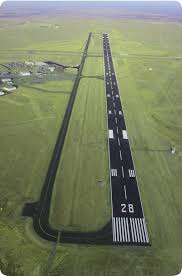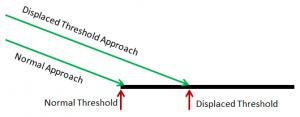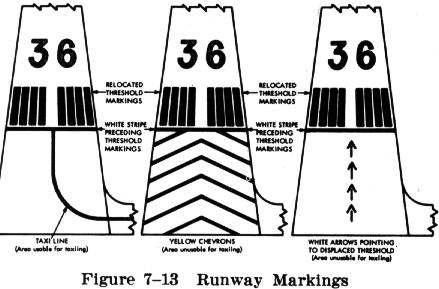You may have heard the term before: “Displaced Threshold;” but you may not know what it actually means. Your airport may not have one, so you probably have never seen what one looks like, or even given it all that much thought.
But a displaced threshold is a common thing to see at an airport, and there are at least a couple of good reasons that your airport might have a displaced threshold or two (or more!).
First – what does a displaced threshold look like? How do you know when you are seeing a displaced threshold?
Let’s start by talking about what a “threshold” is – on airport runways, the threshold is the beginning of the runway. It’s as simple as that.
Or is it?
The runway threshold is marked with white lines parallel to the length of the runway (see image below):
 See at the bottom of the image, the two sets of long skinny white lines, just below the runway number?
See at the bottom of the image, the two sets of long skinny white lines, just below the runway number?
Those are your “Threshold Markings” – telling you where the runway begins. Notice that, in this case, there is no white line perpendicular to the runway length just before the threshold markings, because the pavement just starts right there.
You can’t see it in the picture, but the runway threshold will also have green lights to show a pilot approaching to land where the runway begins at night. If you approached the end of the runway from the other side, you would see red lights instead of green, signifying the runway ending (see image below).

See? Green on one side, red on the other! Neat, huh?
Anyway, a “displaced” threshold is a way to start the actual runway somewhere beyond where the pavement starts.
Why would they do that? Don’t you generally want as much pavement as possible to land on or takeoff from?
There are at least a couple of reasons why a runway threshold would be displaced:
- increases obstacle clearance
- reduces the noise footprint below any approaching aircraft
How does a displaced threshold do this? By elevating the glideslope over any given point along the landing approach.
Whaaaaaa…?
Think about it – actually don’t. Let me draw you a picture.

See how the displaced threshold approach is higher at any given point than the normal approach? So the noise from an approaching aircraft will be less to anyone on the ground because the plane is farther away (higher) – making noise abatement a valid reason for a displaced threshold. It also means that if there were some sort of building or tower in line with the runway, that a landing aircraft could avoid it by flying over it – also a valid reason for a displaced threshold.
So what does a displaced threshold look like? Pretty much the same as a regular threshold, only there will be a white line perpendicular to the length of the runway, AND there will be an indication about what (if anything) the unused pavement CAN be used for:
 On the left, you’ll see the taxiway line extending right up to the displaced runway threshold. In this case, you cannot use the pavement for anything but taxi (or overrun, if landing from the other direction).
On the left, you’ll see the taxiway line extending right up to the displaced runway threshold. In this case, you cannot use the pavement for anything but taxi (or overrun, if landing from the other direction).
In the center, you’ll see chevrons (they will be yellow in the real world) – meaning this area cannot be used for taxi or for takeoff run (but again, could be used for overrun if landing from the other direction). Usually you will see the taxiway enter the runway at or after the displaced threshold in this case.
And on the right, you see arrows (white in real life), meaning the area cannot be used for landing, but should be used for the takeoff run. The common denominator between any of them is that you MUST land at or beyond the threshold, not prior to it in any case. The meanings are mainly important for taking off from this direction – then it’s important to know what the markings mean.
Do you know of any other reasons a displaced threshold might exist? Do you have displaced thresholds at your airport? Land your knowledge in the comments below!
Andrew Hartley is a Certificated Flight Instructor in Columbus, Ohio.
Good Job Andrew ! Well explained… Rob
Hi.
Thank you for article. Is it always safe to aim for the numbers then?
J
Johnny:
“Always” is not a word I use when it comes to aviation, since every situation is different, but simply from the perspective of legality: Yes. The runway numbers will always be on the usable portion of the runway for landing (if there are numbers at all – now ask about grass strips and flying in Alaska or other bush flying strips!).
Hi
Can please provide the all the possible reasons of runway displacement
and which object consider as obstacle
is it the obstacle which intersect with 2% slope or the object which intersect with 3 degree slope
Sachin:
I can’t give all the reasons, but in general, it will be due to obstacles intersecting with that 3-3degree slope you mention. I believe 14 CFR Part 77 explains and defines “obstructions.”
https://www.gpo.gov/fdsys/pkg/CFR-2012-title14-vol2/xml/CFR-2012-title14-vol2-part77.xml
Hi sir!
will you please tell me why Mumbai(chhathrapathi shivaji international airport) runway-14 is displaced threshold.we need this information.Please respond as soon as possible.
Thanks & Regards
M.Muddu Krishna
Global coordinates
VABB Airport management would be able to tell you the actual, specific reasoning for the displaced threshold and its length, but my best guess would be the numerous trees and buildings off the approach end of runway 14, which you can see on the chart here:
http://smartflighttraining.com/wp-content/uploads/2012/11/VABB.png
Hi
Is is possible overrun to the chevrons???
Where is the reason
I can’t find any writing materials in the AIM
Hi
Is it possible overrun to the chevron???
Where is the reason
I can’t find any writing materials in the AIM
(In the AIM, we can’t take off, landing, taxi in the chevron)
Cho: It’s not the best thing to overrun into the chevrons, as usually there is a reason that it is not supposed to be used for takeoff – the chevron area is often called a “blast pad” or an “overrun” but is there becuase the pavement is either:
a) not maintained, or
b) not fully weight-bearing as the remainder of the runway is, or
c) some other reason
But, if you land long or hot (fast), or in an emergency, I’d rather be on less-than-perfect pavement than in a ditch, wouldn’t you? :)
Great article!
One more reason why I think a displaced threshold might be useful and this might a reason why they want you to take off ahead of the area before the threshold.
Preventing debris and dust or even part on the airport equipment to be blown by jet engines.
I don’t know if this is an actual purpose of having a displaced threshold but makes sense to me.
Juan: Thanks! Indeed, as I mention in my response to Cho, above, the chevron-type displaced threshold is sometimes referred to as a “blast pad,” I think for exactly the reason you mention!
Perhaps a displaced threshold may also be introduced if a beginning section of the runway is no longer able to sustain the continuous impact from landing aircraft.
Where does the runup occur prior to take off? Does this occur at threshholds?
Scott – it depends on the airport, but generally, the runup will occur before the hold-short line at any given runway. Always check airport information; I have been to airports where they forbid runups holding short of the runway, so in that case, you would have to do it on the ramp before you taxi, most likely.
Here is a good example of an airport with a displaced threshold and why they should be respected. The danger is not always obvious to the pilot.
https://www.youtube.com/watch?v=yWbg8UH50fA
And one more thing to mention. Runway 17 has a 400 foot displaced threshold. And a note in the AFD “NSTD DSPLCD THLD BAR 5 FT WIDE. RWY NUMBER APPEARS BEFORE THLD BAR”
This is a classic example of why you need to read about the airport before visiting. Visit google maps and zoom in and see how poor the marking is. And how deceptive the threshold is, particularly since the displacement marking are barely visible. –Remember they are 400 feet after the white bar.